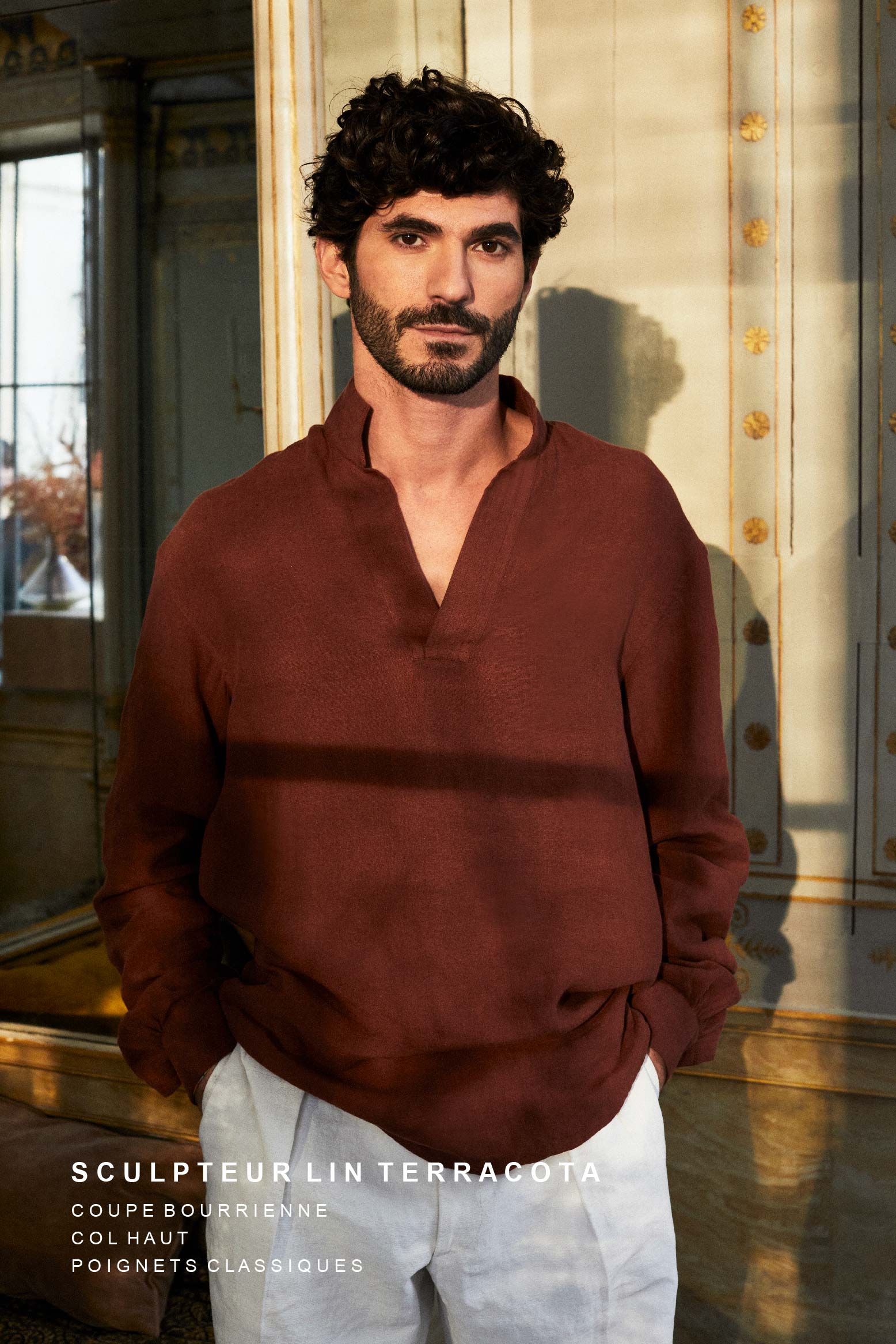
The history of shirt collars
Once upon a time… the story of shirt collars
The collar, this little piece of fabric that wraps around the neck, which largely defines the look of a shirt, has undergone many changes throughout history. Sometimes discreet or downright extravagant, it was decisive in the popularization of the white shirt allowing it to really “raise the collar” in order to become one of the essential pieces of our wardrobe. Back to his story.
When the shirt starts to “grow out of the collar”
The “collar” appeared in Europe at the beginning of the Renaissance, more precisely at the end of the 15th century. It becomes the only visible part of the white shirt which was still struggling to show itself to everyone, hidden under other fabrics. Initially very simple and worn mainly by men of faith, the collar is a symbol of humility and purity. It is gradually integrated into the wardrobe of the nobility which will make it a real fashion phenomenon. Because of this exposure to the public, the shirt collar had to be polished and impeccable.
During the first half of the 16th century, the collar was first raised along the neck and edged with gathers, giving the appearance of a small ruff, before being folded down at the edges over the years 1530. A few decades later, around 1550, the turn-down collar lengthened slightly to have the size we know today without corresponding to the modern collar, developed several centuries later in the 19th century. Indeed, the flap is more like the suspension of the fabric, no folds being present to give the clean look that we are used to seeing these days. It is particularly visible, as it stands out from the dark and austere costume that is characteristic of those years.
 Attributed to François Quesnel, Portrait of Henri III, circa 1580, oil on wood, 66×52 cm, Louvre Museum |
Nevertheless, among courtiers and other gentlemen, the trend of the ruff replaced the collar for a while. However, the latter does not disappear completely. It still appears in particular on portraits of tradesmen, namely men of letters, law and science, but also devotees, mainly Protestants. The flap collar returns to the court of the King of France following the Counter-Reformation, the reaction of the Catholic Church to the Protestant Reformation, which monopolizes this distinctive element of Protestants. This trend somehow marks the return of a certain sartorial austerity that will not last so long.
Luxury and extravagance: the evolution of the collar in the 17th century
As the 17th century progressed, the collar became more and more of a luxury item, it diversified in terms of materials and was adorned with increasingly sophisticated details, such as reticella lace. This is especially the case in England, where members of the court have their portraits taken wearing collars with larger flaps, richly decorated with lace, somewhat reminiscent of strawberries. From then on, this little piece of fabric became a banner of social position, reflecting the wealth of the wearer. Nobles and high bourgeois, recently enriched, competed in creativity, launching fashions, more and more extravagant, in order to establish their position within this ultra-hierarchical society. The collar extends over the shoulders, stiffens – that is to say stiffens – and rises in a high collar to hold as if weightless around the neck of its host, giving it a haughty bearing.The mounted collar gradually takes the form of a rigid, fairly wide plate, endowed with lace teeth characteristic of the early 17th century Due to the extravagance of these pieces, it sometimes happened that they could be dissociated from the body of the shirt.
 Frans Pourbus the Younger, Portrait of Louis XIII, circa 1616 |
The evolution of the collar in the different kingdoms of Europe is indicative of a number of societal developments of each, particularly on the religious level. While Protestant Puritanism spread and imposed itself in Northern Europe, collars tended to remain more reasonable, in terms of sizes and even ornaments, than in southern countries, notably the kingdom of France. . In the French court, the flaps, always starched and sometimes serrated, sag giving rise to the large flap collar covering the collarbones and then the entire shoulders. This type of collar is particularly representative of the reign of Louis XIII.
 Philippe de Champaigne, Louis XIII King of France Crowned by Victory, 1635, oil on canvas, 228×175 cm, Museum of the Louvre |
Return to moderation and sobriety at the end of the 17th century
As the century goes by, the flaps get smaller before lengthening vertically, covering the upper chest. It was around the same time that turned-down collars began to be supplanted by the ancestor of the tie, introduced by Croatian mercenaries commissioned by Louis XIII and Louis XIV to fight alongside the French army. Turn-down collars are relegated to the formal attire of churchmen, magistrates, and ministers.
 Pierre Lacour, René-Nicolas-Charles-Augustin de Maupeou, Chancellor of France, circa 1750, oil on canvas, 134× 103cm, Palace of Versailles |
From the 18th century, the neckline of the shirt again became very basic, more or less plunging, with less starched edges than at the time, which was closed with a strip of fabric, either a lavallière or a regatta (the ancestor of the tie).
The advent of modern collars in the industrial age
The 19th century marks a crucial stage on the road to modernity, on the technical level with the Industrial Revolution, but also on the social and therefore clothing level – if we consider clothing as the materialization of the state of a company. As we mentioned in our article on the emancipation of women, it was at this time that the male costume became more sober and with it, the shirt, a major piece of this costume, was structured. The first tailors flourish in France and England. Shirt making is almost elevated to the state of science. Each of its components is studied, redesigned to correspond to the spirit of the times, to modernity. Mountain passes are no exception to this dynamic.
One of the major advances in the world of shirtmaking came at the start of the 19th century. We are in the 1820s, in Troy, in the United States. Hannah Lord Montague is a housewife there. It is she who takes care of the household chores, in particular the laundry of her husband who wears white shirts.Noting that the dirt is concentrated especially at the level of the collar, she decides to detach all the collars of her husband's shirts and adds a buttonhole to them at the back as well as a button just above the back yoke Without knowing it , the one who simply wanted to save time on her housework has just revolutionized the shirt industry. A few years later, in 1827, detachable collars were mass-produced in all styles, as can be seen in this advertising plate for the Troy-based Cluett blouse. New forms of collars are defined and codified by tailors, most often British or American. Collars with folded flaps thus rub shoulders with broken collars, or high collars of the officer or old tubular type that go up the entire height of the neck. Most of the collars we know today were invented between 1880 and 1910.

With the industrialization of removable collars, the social symbolism of the latter is reinforced. Indeed, "white collar" refers to executives working in offices, as opposed to "blue collar" which refers to workers.
At the beginning of the 20th century, the collar was once again integrated into the shirt body.
Our range of collars at Bourrienne Paris X
To be elegant in all circumstances, Bourrienne Paris X offers a variety of collars.
When it comes to shirts, the French collar remains a safe bet. Considered the classic collar par excellence, it is distinguished by its small opening ideal for slimming your face. To wear with or without a tie.

The top-of-the-range men's white shirt with an Italian collar is one of our brand's timeless products. Ideal for wearing a tie, our white shirts with Italian collar will be the allies of your working days.

Of military origin, the stand-up collar was, as its name suggests, found on the jackets of officers' uniforms in the 19th century. Today, Bourrienne Paris X is rehabilitating it to make it a must for casual elegance.

At the crossroads between an officer collar and a broken collar, the Bourrienne collar is one of the brand's emblematic details. Recognizable by its beveled cut at the front, this Bourrienne collar brings a chic and casual touch to your top-of-the-range men's white shirt.





